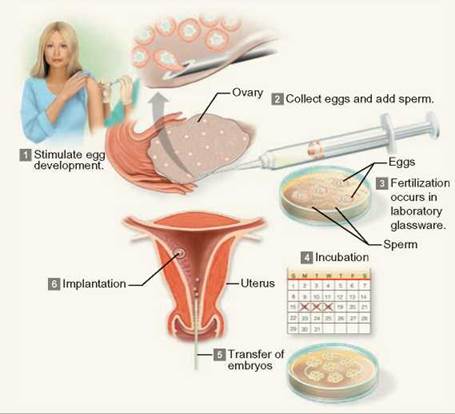CONCEPTS IN BIOLOGY
PART VI. PHYSIOLOGICAL PROCESSES
27. Human Reproduction, Sex, and Sexuality
27.8. The Hormonal Control of Fertility
An understanding of how various hormones influence the menstrual cycle, ovulation, milk production, and sexual behavior has led to the medical use of certain hormones. Some women are unable to have children because they do not release eggs from their ovaries, or they release them at the wrong time (Outlooks 27.2). Physicians can regulate the release of eggs using certain hormones, commonly called fertility drugs. These hormones can be used to stimulate the release of eggs for capture and use in what is called in vitro fertilization (IVF), also called test-tube fertilization. The hormones can also be used to stimulate the release of eggs in women with irregular cycles to increase the probability of natural conception; that is, in vivo fertilization (in-life fertilization) (How Science Works 27.1).
The use of these techniques often results in multiple embryos being implanted in the uterus. This is likely to occur because the drugs may cause too many eggs to be released at one time. In the case of in vitro fertilization, because there is a high rate of failure and the process is expensive, typically several early-stage embryos are inserted into the uterus to increase the likelihood that one will implant. If several are successful, multiple embryos implant. The implantation of multiple embryos makes it difficult for one embryo to develop properly and be carried through the entire nine-month pregnancy. When scientists understand the action of hormones better, they may be able to control the effects of fertility drugs and eliminate the problem of multiple implantations.
Another medical use of hormones is the control of conception with birth-control pills—oral contraceptives. Birth- control pills have the opposite effect of fertility drugs. They raise the levels of estrogen and progesterone, which slows the production of FSH and LH, preventing the release of eggs from the ovaries. They can also help relieve premenstrual syndrome (PMS), which causes irritability, emotional instability, depression, headache, and other aches and pains.
The hormonal control of fertility is not as easy to achieve in men, because there is no comparable cycle of gamete release. However a new, reversible male conception control method for males has been developed. It relies on using a combination of progestin, a hormone used in female contraceptive pills, and testosterone. The combination of the two hormones temporarily turns off the normal brain signals that stimulate sperm production.
OUTLOOKS 27.2
Causes of Infertility
Infertility is a problem that has generated a major branch of medicine to diagnose and treat the causes. Either or both partners can be the cause of the infertility in a relationship, so both need to be assessed in the process of diagnosis and treatment. In about 35% of cases, the fertility problem involves the female; in about 35%, of cases, the fertility problem involves the male. In about 20% of cases, both partners have a problem, and no cause has been identified in about 10% of cases.

Common Causes of Infertility
Lifestyle Causes
Heavy use of alcohol and drugs
Low body fat or anorexia in women
Tight clothing in men may raise the temperature in the scrotum and affect sperm development.
Stress may cause irregular ovulation in women or reduce sperm count in men.
Infections
Sexually transmitted diseases often result in scarring of blockage of reproductive tubes.
Pelvic inflammatory disease (PID) is the most common cause of infertility in women.
Physical Causes
Fibroids and endometriosis may cause blockage.
Retrograde ejaculation—the semen is forced into the bladder rather than being ejaculated.
Developmental Causes
Undescended testes
Swollen veins (varicocoele) in scrotum
Undeveloped ovaries or testes (developmental defect, infection, etc.)
Hormonal Causes
Any imbalance in the timing and quantity of the several sex hormones can result in lack of ovulation.
The uterus may not be prepared to accept the embryo.
Low progesterone levels may cause premature shedding of the uterine lining.
Low testosterone levels results in low sperm counts.
Immune System Causes
Females may develop antibodies against her partner's sperm.
Males may develop an autoimmune response to their own sperm.
Illness and Medication Causes
Diseases such as diabetes, kidney disease, and high blood pressure contribute to infertility.
Tranquilizers and blood pressure drugs may interfere with erection.
HOW SCIENCE WORKS 27.1
Assisted Reproductive Technology
The Centers for Disease Control and Prevention defines assisted reproductive technology (ART) as "all fertility treatments in which both eggs and sperm are manipulated. In general, ART involves surgically removing eggs from a woman's ovaries, combining them with sperm in the laboratory, and returning them to the woman's body or donating them to another woman. It does NOT include procedures in which only sperm are manipulated (i.e., artificial insemination or intrauterine insemination) or procedures in which a woman takes drugs only to stimulate egg production, without the intention of having eggs retrieved." There are three types of ART: in vitro fertilization (IVF), gamete intra-fallopian transfer (GIFT), and zygote intra-fallopian transfer (ZIFT).
In vitro fertilization is a method that uses hormones to stimulate egg production, removing the egg or eggs from the ovary, and fertilizing it with donated sperm. The fertilized egg is incubated to stimulate cell division in a laboratory dish and then placed in the uterus. (See figure.)
GIFT relies on the same hormonal treatment as IVF to stimulate ovulation. The physician observes the transfer of unfertilized eggs and sperm into the woman's fallopian tube through an instrument inserted through a small incision in her abdomen. Once fertilized, the zygote moves down through the fallopian tube into the uterus and implants. GIFT is only an option for women with open fallopian tubes.
In the ZIFT procedure, a woman's mature eggs are collected and fertilized in the laboratory. Then, the zygote is inserted into the fallopian tube through a small abdominal incision. The embryo will then travel down the fallopian tube and implant in the uterus in a normal manner.

27.8. CONCEPT REVIEW
17. How do birth control pills prevent ovulation?